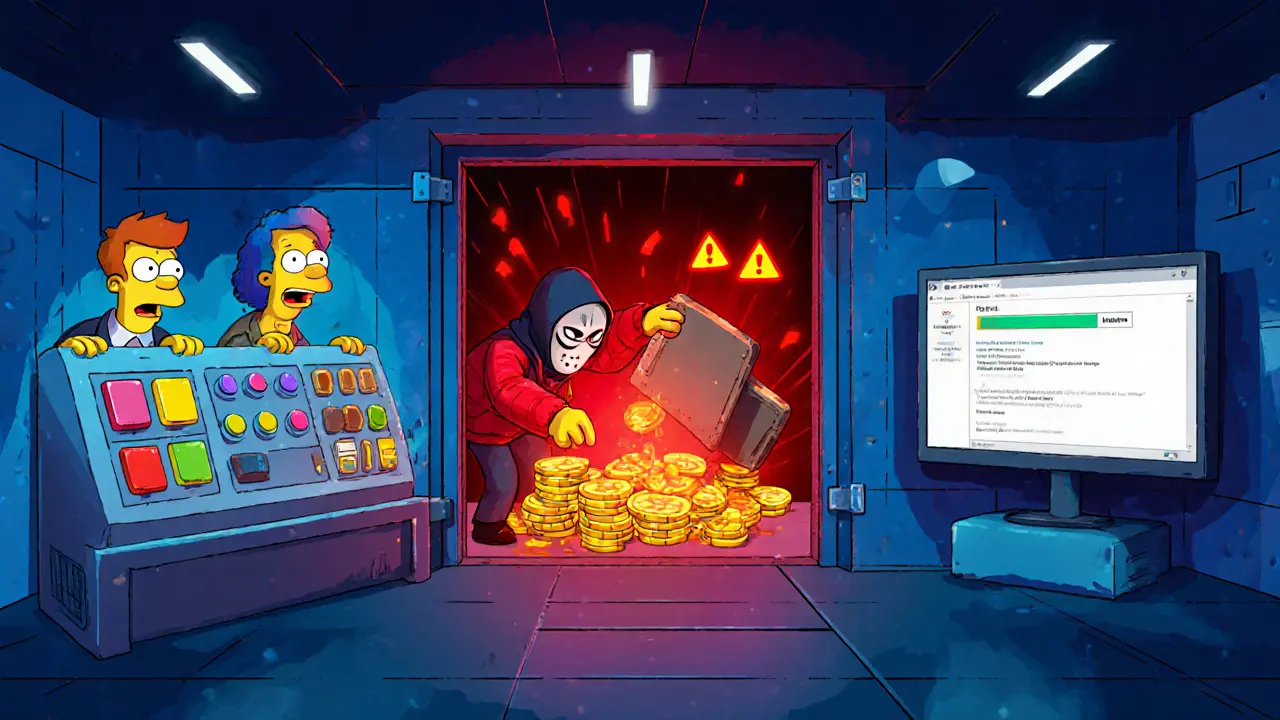CEX Security Risk Calculator
Assess your vulnerability to centralized exchange risks based on your current security practices. Input your current security measures to calculate your risk exposure and learn how to improve your protection.
Your Current Security Measures
Quick Takeaways
- Custodial control means users don’t truly own their tokens until they withdraw to a personal wallet.
- Only ~38% of top CEXs use true multi‑signature wallets; the rest rely on single‑key setups.
- Cold storage averages 63% of assets - far below the recommended 95%+ for optimal safety.
- From 2014‑2023, 100% of the $3.8 billion stolen in crypto breaches came from CEX hacks.
- Mitigation steps-hardware wallet integration, address whitelisting, and strong 2FA-reduce loss risk by up to 85%.
When you hear the phrase centralized exchange risks, you’re probably thinking of headlines about stolen millions, withdrawal freezes, or sudden platform shutdowns. Those stories are the tip of an iceberg built on a custodial model where a single authority holds your private keys. This guide breaks down the core vulnerabilities, shows how they differ from decentralized alternatives, and gives you concrete steps to protect your tokens.
What Is a Centralized Exchange?
Centralized Exchange is a platform that matches buyers and sellers of digital assets under a single corporate authority. The exchange controls the private keys for any token stored in user accounts, meaning the platform, not the user, technically owns the assets until they are withdrawn to a self‑custody wallet. This custodial architecture enables features most newcomers love: instant fiat on‑ramps, slick UI, high‑speed order matching, and deep liquidity.
Major players-Binance, Coinbase, and Kraken-process trillions of dollars annually, but that volume comes with a single point of failure.
Core Security Vulnerabilities
Three technical pillars define a CEX’s security posture: key management, asset storage, and software hygiene.
- Key Management. True multi‑signature wallets require multiple independent approvals for withdrawals. The 2023 CipherTrace report found only 38% of the top 20 exchanges employ authentic multi‑sig setups; the rest still rely on a single private key, making them prime targets for insider threats or credential theft.
- Cold Storage Allocation. Best practice recommends keeping at least 95% of holdings offline. Chainalysis data from Q1 2024 shows the industry average sits at 63%, leaving a large hot‑wallet exposure that can be drained in seconds-Binance reported an average trade execution time of 0.5 seconds, which also means a breach can move funds nearly instantly.
- Patch Management. The average time to remediate a known vulnerability in 2023 was 47 days (CoinGecko’s Exchange Security Index). Delayed updates give attackers a predictable window to exploit flaws that have already been disclosed publicly.
These weaknesses translate into real‑world losses. Between 2014 and 2023, 97% of high‑profile hacks exploited inadequate security protocols, according to OSL Academy’s 2023 analysis.

Historical Hacks and Their Lessons
The most infamous early collapse was Mt. Gox in 2014, which vanished with roughly 850 000 BTC-about $450 million at the time. Fast‑forward to recent years, and the pattern repeats:
- WazirX (Nov 2023): $570 million stolen; insurance covered only 20% of user balances, leaving most victims uncompensated.
- Coinbase (May 2021): Withdrawal suspension affected 1.2 million users during a market crash.
- Binance (Feb 2024): Introduced mandatory withdrawal address confirmation delays after a social‑engineering scam stole $85 million across multiple platforms.
All these incidents share two root causes: custodial control without sufficient multi‑sig safeguards and slow response or communication to users.
CEX vs. DEX: Risk Trade‑offs
Decentralized exchanges (DEXs) eliminate the custodial layer-users trade directly from their wallets, and tokens never leave their private keys. However, DEXs sacrifice liquidity and fiat integration.
| Aspect | Centralized Exchange | Decentralized Exchange |
|---|---|---|
| Custody | User funds held in exchange wallets (custodial) | User funds remain in personal wallet (non‑custodial) |
| Liquidity | 98.7% of total crypto trading volume | ~1.3% of volume; cheaper slippage on large trades |
| Regulatory Compliance | Supports fiat on‑ramps, KYC/AML | Generally off‑ramp only; limited KYC |
| Security Incidents (2023) | $3.8 billion stolen (100% of crypto exchange thefts) | 0 billion stolen (no major DEX hacks reported) |
| User Experience | Intuitive UI, instant deposits/withdrawals (subject to freezes) | Requires wallet setup, gas fees on every trade |
While DEXs avoid custodial risk, they expose users to smart‑contract bugs and higher transaction fees. Most traders still start on CEXs for convenience, with 83% of new crypto users in 2023‑2024 beginning on a centralized platform.
Practical Steps to Reduce Your Token Risk
Even if you prefer the ease of a CEX, you can dramatically cut exposure by adopting five best‑practice safeguards:
- Hardware Wallet Integration. Store the bulk of your holdings in a device like Ledger or Trezor. Only keep a trading‑size amount on the exchange. Ledger’s 2024 survey shows only 12% of users actually do this.
- Withdrawal Address Whitelisting. Enable the feature that restricts outgoing transfers to pre‑approved addresses. Currently, only 38% of active traders use whitelisting.
- Strong Multi‑Factor Authentication. Move beyond SMS codes to authenticator apps (Google Authenticator, Authy). Adoption sits at 41% for authenticator‑based 2FA.
- Transaction Signing Verification. Some exchanges let you confirm a withdrawal via a signed message from a linked hardware wallet. Roughly 22% of users have enabled this extra check.
- Regular Policy Audits. Review the exchange’s security whitepaper, insurance coverage, and incident response timeline at least once a quarter. Only 8% of retail users perform such audits.
Implementing all five takes about 3-5 hours initially and 15-20 minutes each month for reviews, according to Coinbase’s 2024 Security Guide.
Regulatory Landscape and Insurance Gaps
Regulators are tightening the leash on custodial platforms. The EU’s MiCA rules (effective June 2024) require a minimum €150,000 capital reserve and real‑time transaction monitoring. In the U.S., the SEC filed 57 enforcement actions against exchanges in 2023, up from 29 in 2022.
Insurance is another weak spot. While some Tier‑1 exchanges now offer up to 100% coverage for assets up to $1 million per user (Kraken’s 2024 hack insurance), the average coverage across the industry remains 15‑25% for emerging market platforms. This disparity leaves users vulnerable, especially during rapid market moves when withdrawals may be halted.
Future Outlook: Institutional‑Grade Custody on CEXs?
Recent upgrades signal a shift toward more robust custody solutions:
- Coinbase launched institutional‑grade multi‑party computation (MPC) wallets for all users in March 2024.
- Kraken introduced real‑time hack insurance covering 100% of balances up to $1 million per user.
- Binance added mandatory withdrawal address delay mechanisms to curb social‑engineering attacks.
Analysts predict that by 2025, 78% of Tier‑1 exchanges will embed native self‑custody options, reducing the custodial gap. However, a Deloitte survey cautions that 35‑40% of current exchanges could consolidate or fail within five years due to persistent security and compliance pressures.
Bottom Line
Centralized exchanges offer unmatched convenience and liquidity, but the trade‑off is a custodial risk that has repeatedly resulted in multi‑billion‑dollar losses. By understanding the technical flaws, staying aware of regulatory changes, and applying concrete security habits, you can keep the benefits while protecting your tokens from the most common failure points.
Why are custodial wallets considered risky?
Because the exchange holds the private keys, users don’t truly own the tokens until they move them to a personal wallet. If the exchange is hacked, mismanaged, or goes bankrupt, the assets can be lost or frozen.
What percentage of exchange assets should be in cold storage?
Industry best practice recommends at least 95% of user funds be kept offline in cold storage. The current average is around 63%.
How can I protect my account on a CEX?
Use a hardware wallet for the majority of your holdings, enable address whitelisting, set up authenticator‑app 2FA, enable any optional transaction‑signing verification, and review the exchange’s security policies quarterly.
Are exchange hacks more common than DEX exploits?
Yes. In 2023, $3.8 billion was stolen in exchange breaches, while major DEXs reported virtually no direct token thefts, though they face smart‑contract risks.
What insurance options do CEXs provide?
Top tier exchanges may offer up to 100% coverage for balances up to $1 million per user (e.g., Kraken). Most others provide only 15‑25% coverage, leaving a large uninsured portion.



Comments
I've been on Binance for years and never had an issue, but reading this made me realize I've been lazy. I keep 90% of my stuff on there because it's easy. Guess it's time to move the bulk to my Ledger. Not fun, but worth it.
Just set up address whitelisting today. Took 20 minutes. Feels better already.
they all get hacked eventually. its not if its when. cexs are just government backdoored casinos. they know your ip, your id, your balance. the whole system is rigged. why are you still using them? just use dexcash and get over it. theyre not even real money anyway.
Y'all, I know this sounds like a lecture but seriously-do the 3 things: hardware wallet, 2FA via Authy, and address whitelisting. It literally cuts your risk by 80%. I used to be scared to even touch crypto until I did this. Now I sleep like a baby. You don’t need to be a tech wizard, just consistent.
And yes, I know it’s annoying. But so is losing your life savings because you clicked 'skip' on security settings. You got this!
This post is basically common sense dressed up like a whitepaper. 63% cold storage? That’s pathetic. Anyone using a CEX without a hardware wallet is asking for trouble. And don’t get me started on SMS 2FA-what, are you using a flip phone? Authenticator apps have been free for a decade. The fact that 59% of users still don’t use them proves the crypto space is full of amateurs who think ‘buy and HODL’ is a strategy. Stop being lazy. Your keys, your coins. If you don’t know that by now, you shouldn’t be here.
Agreed on the 95% cold storage ideal. Real talk: most retail users don’t even know what MPC is, let alone how to enable it. Coinbase’s rollout was a quiet win-non-custodial UX without the complexity. But the real gap? Insurance literacy. Only 8% audit policies. That’s not negligence, that’s systemic ignorance. We need onboarding that doesn’t assume crypto-native fluency.